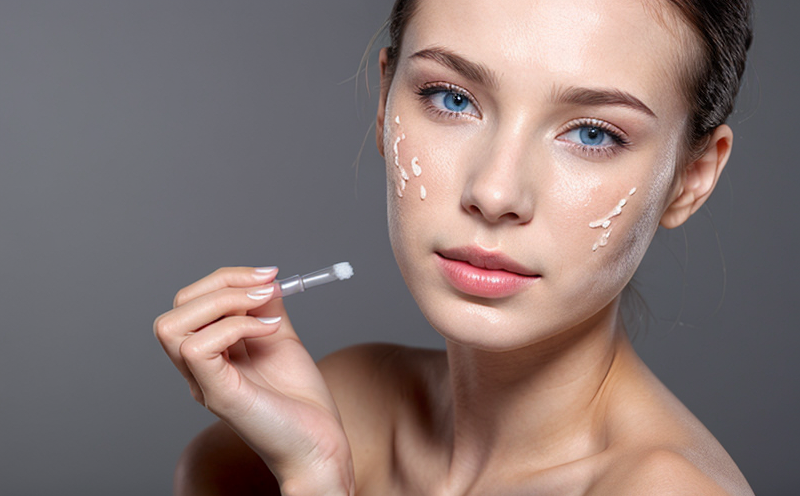Human Repeat Insult Patch Test for Skin Sensitization
The Human Repeat Insult Patch Test (HRIT) is a pivotal method used in cosmetics testing to assess the potential of a cosmetic product or ingredient to cause skin sensitization. This test, which is closely aligned with international standards such as OECD 410 and EU Regulation 1907/2006, involves applying the test substance multiple times on the skin over an extended period, typically up to seven days, followed by a patch test after 24 hours of removal. This rigorous procedure aims to identify substances that can cause allergic contact dermatitis, which is a significant concern in the cosmetic industry.
The HRIT protocol is designed to mimic real-world scenarios where individuals may be exposed repeatedly to allergens over time. The test subjects are typically volunteers who undergo repeated applications of the test article on different areas of their skin. Following each application and removal, the area is monitored for signs of irritation or sensitization.
The testing process involves several critical steps: first, the selection of appropriate test substances based on risk assessment and historical data. Second, the preparation of the test articles must adhere to strict quality control measures. Third, the patch tests are conducted under controlled conditions in a laboratory setting, ensuring that environmental factors do not interfere with the results.
The acceptance criteria for HRIT are stringent, requiring no more than 25% of subjects to show signs of sensitization or irritation after the repeat insults. This ensures that only products and ingredients with a low risk of causing allergic reactions pass this critical test. The method is widely recognized for its reliability and predictive value in identifying potential allergens early in product development.
Understanding the HRIT process not only helps regulatory compliance but also supports the ethical responsibility of ensuring consumer safety. By implementing this test, cosmetic manufacturers can contribute to reducing the incidence of allergic contact dermatitis, enhancing public trust, and maintaining a positive brand image.
The HRIT is essential for new product development in cosmetics, ensuring that ingredients are safe for repeated use. It plays a crucial role in protecting consumers from potential allergens while allowing innovation in cosmetic formulations. The test's outcome directly influences the decision-making process in product formulation, influencing ingredient selection and final product release.
Given its importance in the industry, the HRIT is typically conducted by specialized laboratories equipped with state-of-the-art facilities and experienced personnel. These labs ensure that all tests are performed according to rigorous standards, thereby providing accurate and reliable results. The data generated from these tests can be pivotal for regulatory submissions, supporting both local and international compliance requirements.
In conclusion, the HRIT is a cornerstone in ensuring product safety and quality within the cosmetics sector. Its role extends beyond mere compliance; it fosters innovation by guiding formulation decisions that prioritize consumer well-being. By adhering to this stringent protocol, manufacturers can contribute significantly to reducing the prevalence of allergic reactions, thereby enhancing public health.
Benefits
The Human Repeat Insult Patch Test offers several significant benefits for cosmetic manufacturers:
- Regulatory Compliance: Ensures adherence to international standards and regulatory requirements, such as OECD guidelines.
- Risk Management: Identifies potential allergens early in the product development process, allowing for informed decision-making.
- Patient Safety: Minimizes the risk of allergic contact dermatitis by ensuring product safety.
- Innovation Support: Guides formulation decisions, fostering safer and more effective cosmetic products.
- Brand Reputation: Enhances brand image by demonstrating a commitment to consumer health and well-being.
Customer Impact and Satisfaction
The implementation of the HRIT significantly impacts customer satisfaction and loyalty. By ensuring that cosmetic products are free from potential allergens, manufacturers can build trust with their customers, thereby fostering long-term relationships. This is particularly important in an industry where consumer safety and product quality are paramount.
Customers appreciate transparency regarding product safety, especially given the prevalence of allergic reactions to cosmetics. The HRIT not only addresses these concerns but also provides peace of mind for consumers who use a wide range of cosmetic products daily. This enhanced trust can lead to higher customer satisfaction and increased loyalty, as customers are more likely to return to brands they perceive as safe and reliable.
The HRIT also supports the broader industry by setting a benchmark for product safety standards. When manufacturers adhere to this rigorous test protocol, it sets an example that encourages competitors to follow suit, thereby elevating overall industry standards. This collective effort contributes to a safer market environment, ultimately benefiting consumers across the board.
Competitive Advantage and Market Impact
The Human Repeat Insult Patch Test provides cosmetic manufacturers with a competitive edge by ensuring that their products are safe for repeated use. This distinction is crucial in a market where product safety and efficacy are key differentiators. By demonstrating a commitment to rigorous testing, companies can differentiate themselves from competitors who may not adhere to the same standards.
Adhering to the HRIT protocol not only enhances brand reputation but also opens doors to international markets that have stringent regulatory requirements. Many countries, especially those in Europe and North America, require products to pass this test before being sold within their jurisdictions. By meeting these standards, manufacturers can expand their market reach, thereby increasing sales potential.
The HRIT's role extends beyond mere compliance; it supports innovation by guiding formulation decisions that prioritize consumer well-being. This proactive approach not only enhances product safety but also allows companies to introduce safer and more effective products, which are increasingly in demand among health-conscious consumers. The resulting improved market position can lead to increased market share and profitability.





